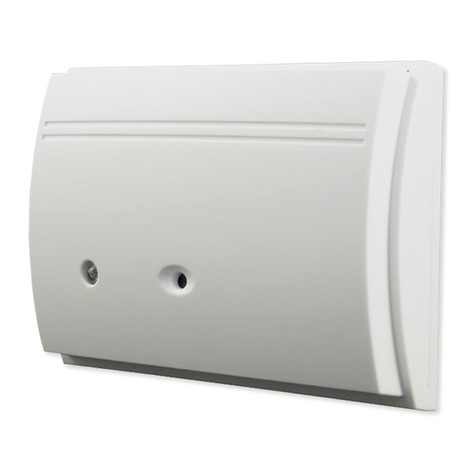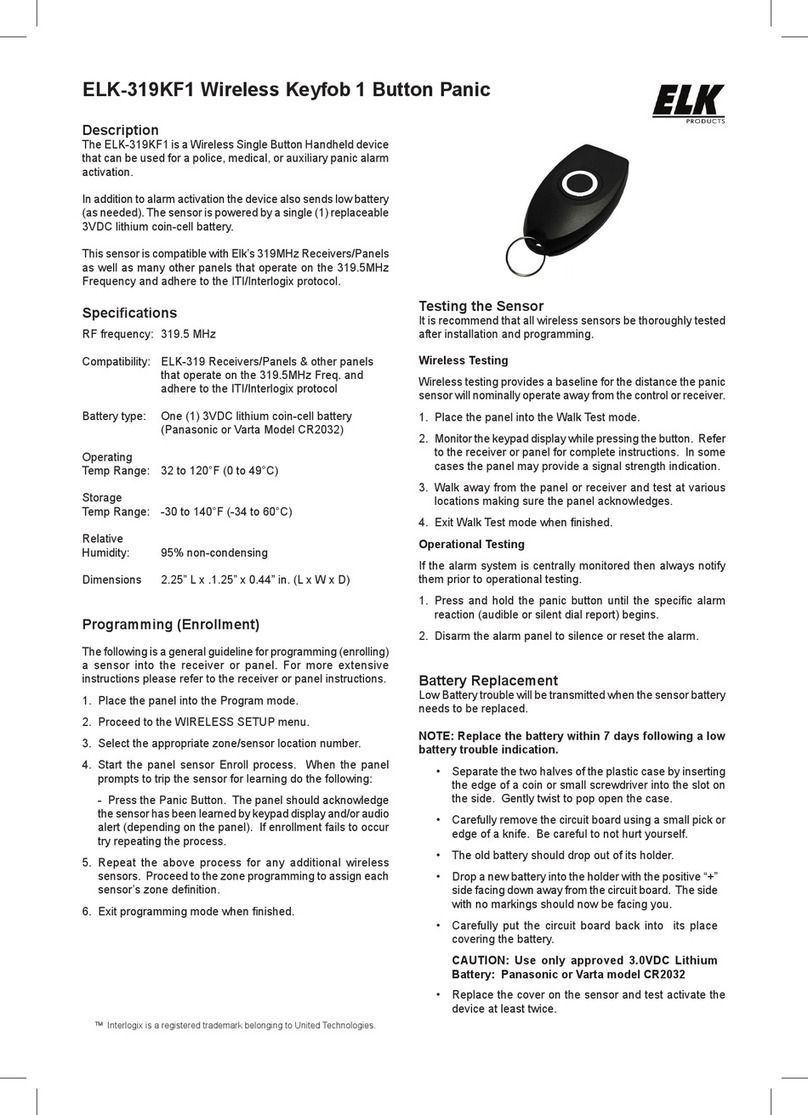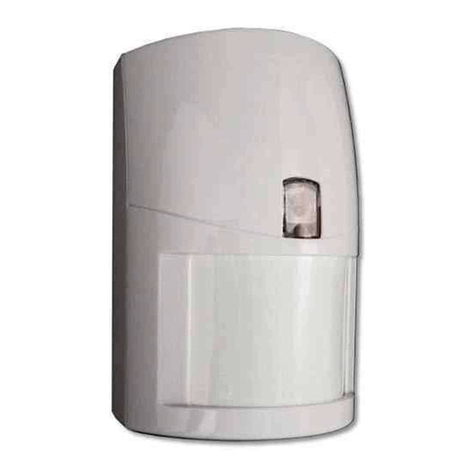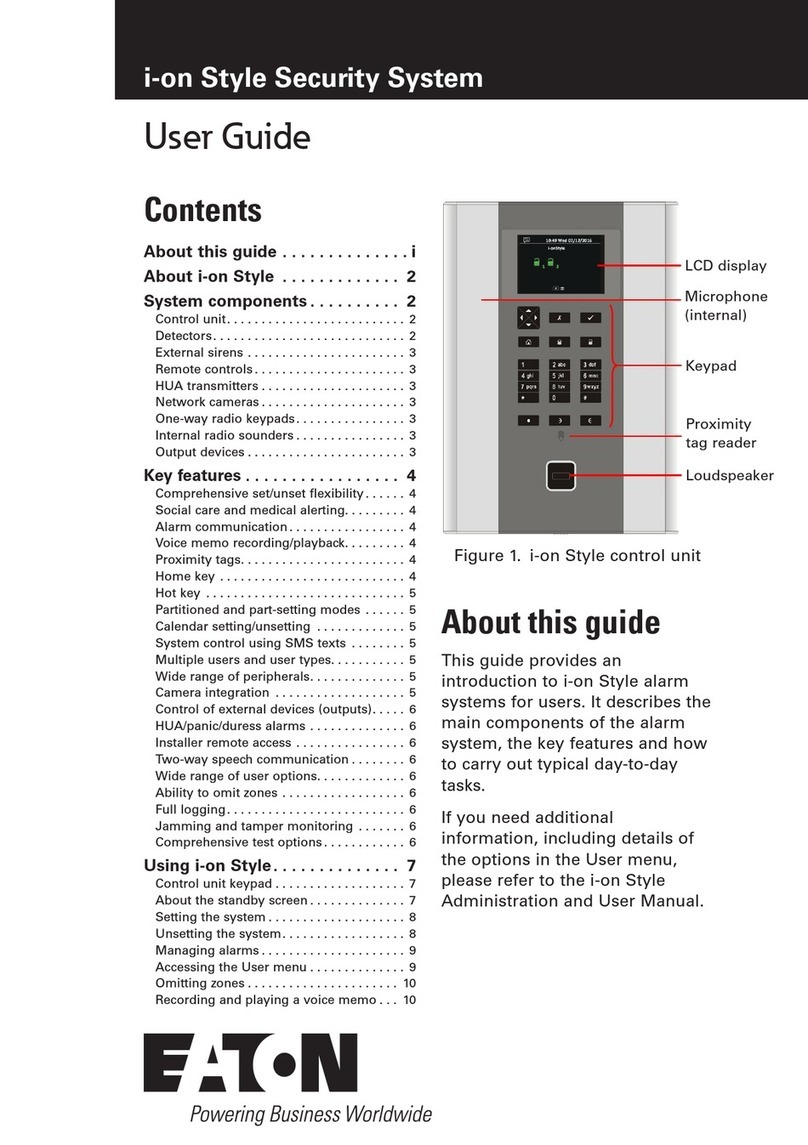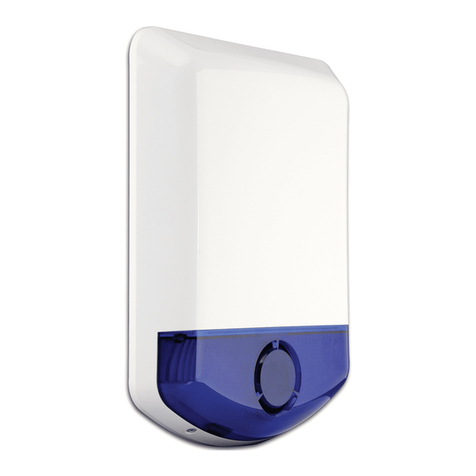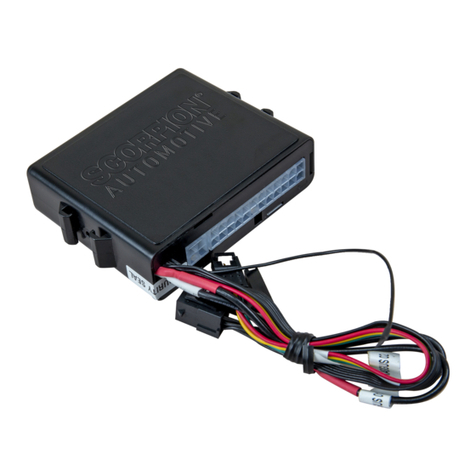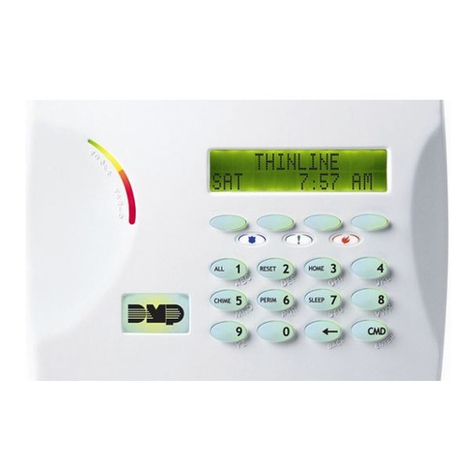Elk Guard Assembly instructions

Installation
&
Programming
Manual
SelfSelf
SelfSelf
Self--
--
-ContainedContained
ContainedContained
Contained
WW
WW
Wireless Security Systemireless Security System
ireless Security Systemireless Security System
ireless Security System
ELK106INST Rev C 08/13/2008 FW V1.2
ElkGuard TM

Page2 ElkGuardInstallation&Programming Manual V1.2
FCCSTATEMENT:
THISDEVICECOMPLIESWITHPART15OFTHEFCCRULES. OPERATION ISSUBJECTTOTHEFOLLOWINGTWOCONDITIONS:(1)THIS
DEVICEMAYNOTCAUSEHARMFULINTERFERENCE,AND(2)THISDEVICEMUSTACCEPTANYINTERFERENCERECEIVED,INCLUDING
INTERFERENCETHATMAYCAUSEUNDESIREDOPERATION.
NOTE: THEMANUFACTURERISNOTRESPONSIBLEFORANYRADIOORTVINTERFERENCECAUSEDBYUNAUTHORIZEDMODIFICA-
TIONSTOTHISEQUIPMENT.SUCHMODIFICATIONSCOULDVOIDTHEUSER’SAUTHORITYTOOPERATETHEEQUIPMENT.
This equipment generates and uses radio frequency energy and if not installed and used properly, that is, in strict accordance with the
manufacturer’s instructions, may cause Interference to radio and television reception. It has been type tested. However, there is no
guarantee that interference will not occur in a particular installation. If this equipment does cause interference to radio or television
reception, which can be determined by turning the equipment off and on, the user is encouraged to try to correct the interference by
one or more of the following measures:
* If using an indoor antenna, have a quality outdoor antenna installed.
* Reorient the receiving antenna until interference is induced or eliminated.
* Move the receiver away from the security control.
* Move the antenna leads away from any wire runs to the security control
* Have the device or controller plugged into a different outlet so that it and the receiver are on different branch circuits.
If necessary, the user should consult the dealer or an experienced radio/television technician for additional suggestions. The user or
installer may find a booklet titled “Interference Handbook” prepared by the Federal Communications Commission helpful: This booklet is
available from the U.S. Government Printing Office, Washington, DC 20402. The user shall not make any changes or modifications to
the equipment unless authorized by the Installation Instructions or Users Manual. Unauthorized changes or modifications could void the
user’s authority to operate the equipment.
List ofAvailable Devices
Part # Description FCCIDNumber
106057 ElkGuard Wireless Alarm System - “Local Only” No Communicator FCC ID: O2K-106058
106058 ElkGuard Wireless Alarm System with Cellular “GSM” Communicator FCC ID: O2K-106058
Includes: Cellular “GSM/GPRS” Radio Modem Transmitter Module FCCID: MIVGSM0108
106064 Wireless Mini Door & Window Switch Transmitter (RR1) FCC ID: O2K-106064
106065 Wireless Universal Transmitter w/ext input & Vib analyser (RR2) FCC ID: O2K-106065
106068 Wireless 4 Button Keyfob Transmitter (RK4) FCC ID: O2K-106068
106053 Wireless 3 Button Keyfob Transmitter (RK3) FCC ID: O2K-MK304
106050 Wireless 1 Button Bracelet / Neckless Panic Transmitter (RK1) FCC ID: O2K-106050
106054 Wireless Emergency Button Transmitter (RPB) FCC ID: O2K-106054
106056 Wireless Door Bell Button Transmitter (RDB) FCC ID: O2K-106056
106051 Wireless PIR with Pet Immunity (R15PET) FCC ID: O2K-106051
106062 Wireless PIR - Non Pet Immune (R15) FCC ID: O2K-SPIR304
106066 Wireless Radio Keypad (RKP) FCC ID: O2K-106066
106060 Swivel Mounting Bracket for Wireless PIR N/A

ElkGuardInstallation&Programming Manual V1.2 Page 3
Table of Contents
Application, Features, & Specifications............................................................................ 4
Mounting ............................................................................................................................. 5
Start Up ............................................................................................................................... 7
Version Number.........................................................................................................................................7
User Modes......................................................................................................................... 7
DeviceAllocation................................................................................................................ 8
Device Categories .............................................................................................................. 8
Alarms ................................................................................................................................. 9
System Troubles............................................................................................................... 10
Panic/Duress Operation................................................................................................... 10
Battery Management ........................................................................................................ 11
AC Mode as Primary ............................................................................................................................... 11
Battery Mode as Primary ........................................................................................................................ 11
How can ElkGuard operate so long on battery power only? .............................................................. 11
How is the Battery Mode operating time affected by alarms and daily activity? .............................. 11
Battery Load Test .................................................................................................................................... 12
Nonvolatile Memory ......................................................................................................... 12
System Feedback............................................................................................................. 12
Programming .................................................................................................................... 13
Entering Programming Mode.......................................................................................................13
Exiting from Programming Mode.................................................................................................13
Programming Mode Navigation and Selection.............................................................................13
Learning New Devices ................................................................................................................14
Erasing/Replacing Devices .........................................................................................................14
Programming Notes ....................................................................................................................14
Program Menu Options.................................................................................................... 15
OptionalAuxiliary Connections....................................................................................... 23

Page4 ElkGuardInstallation&Programming Manual V1.2
Features
•BuiltInPassiveInfrared (PIR) Motion Detector
• BuiltIn Wireless Receiverfor sensors and keyfobs
• Upto 23 supervised and encrypted wireless devices inclusive of 1 keyfob min.
•6Characteralphanumericdisplay
•Capableof operating on batteryfor 3 monthsor longer betweenrecharges (in Battery Only mode)
•Available with orwithout Cellular GSM Alarm Communicator
•VoiceAnnunciation (status, events, user instructions)
•Multiplearming modes (ARMED, STAY, STAY2)
•Adjustmentvolumeof system soundsand voice annunciation
•OptionalStrobeLight with alarmmemory
•OptionalExternalSpeakerfor Siren
•Memory and Visual indication of LastAlarm Event
•Non-VolatileProgramMemory
ElkGuard is a fully self contained security system. It features an on-board motion sensor, loud siren, and
wirelessreceiver for remote sensors andArm/Disarm keyfobs. There areseveral power options, including “AC
Power” primary and “Battery Only” modes. In the “Battery Only” mode ElkGuard is capable of operating for up
to 3 months between recharges, depending upon activity and communication options selected. The ability to
operate for long periods of time withoutAC power sets ElkGuard apart from its competitors and means less
maintenance for the customer. ElkGuard is manufactured to world class standards using the latest surface
mount technology and state of the art in-circuit probe testers, together with strict process controls and
adherenceto an ISO9001 QualityAssurance Program, ensuring a quality product and a long service life.
ElkGuard is available with our without a Cellular GSM radio communicator. The GSM radio allows ElkGuard to
communicate to a central monitoring station wirelessly, making it totally independent of landline phones.This
featurealone affords ElkGuard with unprecedented easeof installation and portability.
Completecontrol of the ElkGuard is available fromwaterproof remote wireless keyfobs, which provides theuser
with separate on and off buttons plus a panic button.
ElkGuard not only visually reports all events to the user via its large, bright alphanumeric display, it actually
speaks to the user to report events and advises on the action to take.
ElkGuard contains the latest microprocessor technology ensuring the highest level of security and
dependability. The wireless keyfobs utilize proprietary encryption algorithms to remove the risk of code
duplication by would be intruders though the use of “Code Grabbers.” Detection devices such as wireless
passiveinfrared detectors and wireless reed switches also offer a high level of security through the use of
programmablesupervision techniques and constant monitoringof their battery condition.
ElkGuard also helps resolve the growing issue of manpower and experience when it comes to installation.A
basic install can be completed in minutes using only a screwdriver to mount the equipment. Minimal
programmingis required allowing a comprehensive system to be installedin under one hour.
Application, Features, & Specifications
Specifications
• Dimensions (H x W x D): 20.5 x 4.5 x 3.3 Inches
• OperatingVoltage: 12Vdc
• Standby Battery: 12V 3.3Ah
• Weight: 5.75 lbs (including battery)
• Plug-inPowerPack/Charger:18VAC400mAClass2Transformer

ElkGuardInstallation&Programming Manual V1.2 Page 5
Mounting
Select a mounting location for the ElkGuard in a main area of the building or home with consideration of the
followingrecommendations:
1) ElkGuard needs to be high enough in the corner of the room for the motion detector to cover the most
space possible. The ideal mounting height is at least 70" from the floor to the bottom of the unit.
2) The Cellular GSM Radio version of ElkGuard requires access to a nearby GSM transmission tower. It
cannot function without adequate signal strength. Some buildings or locations may not be conducive to
GSM coverage OR the location within the building may so critical that the location of ElkGuard will need to
be adjusted to obtain the best possible signal strength.
3) Even thoughElkGuard is capable of operating on battery for 3 between recharges (in Battery Only mode),
connection to anAC electrical outlet (if available) is certainly a good practice as it would eliminate the need
to remember to periodically recharge the unit manually.
Figure1
The design of the ElkGuard makes it ideal for mounting in the corner of a room or to any flat surface. Adifferent
set of mounting holes are used when mounting the unit in a corner versus a flat surface as illustrated in Figure 3
onthefollowingpage.
To access the mounting holes first remove the speaker grill by holding the main unit and pulling the speaker
grill away from the main cover at the top using the opening tab as shown below.
Next, remove the display face plate by holding the main unit and pulling the face plate away from the main unit
using the opening tabs located on each side of the face plate as shown below.
Figure2

Page6 ElkGuardInstallation&Programming Manual V1.2
After removing the speaker grill and faceplate, position the unit on the wall vertically level where it will be
mounted and mark the appropriate mounting holes. This will indicate where to drill the holes for the anchors.
Use a 3/8" drill bit.
Squeeze the anchor tabs down and press the anchor into the hole. The anchors will fit tight so try not to bend
the anchor. Repeat for all of the holes you drilled.
When all the mounting anchors are in place, insert the screws through the mounting holes and into the
anchors. Do not overtighten the screws. Anchors can be stripped out if screws are over tightened.
Snap the speaker grill and display face plate back into place.
After mounting the unit, plug in theAC transformer for 24 hours. This will ensure the onboard battery is fully
charged.
NOTE:
The two (2) factory
supplied Keyfobs are
stored behind the
removable lower
faceplate.
Corner
Mounting
Holes
Corner
Mounting
Holes
Flat
Mounting
Holes
Flat
Mounting
Holes
Figure 3

ElkGuardInstallation&Programming Manual V1.2 Page 7
Start Up
To power up ElkGuard insert one of the two round barrel keys into the lock on the bottom edge of the unit. Turn
the key clockwise 1/4 turn and the unit will momentarily display its Version Number, follwed shortly thereafter
by “Learn”. If the unit was previously in any state other than disarmed, this mode will time out in 30 seconds.
During this time the triggers for the main motion detector are ignored. After the time has expired the unit will
resumethe mode quietly (without usual arming sounds).
Version Number
Upon initial power up the display will show the current firmware version of the unit. The first production units
began at version 1.0. Please note that any modifications or additional features as a result of a firmware version
change will be highlighted or noted within this manual..
User Modes
ElkGuard has four different modes, DISARMED,ARMED, STAY, and STAY2. This allows the user to set
different levels of security when they are home or away. It is very easy to scroll through the available armed
modes by pressingArm/Lock key on the keyfob multiple times. To disarm simply press the Disarm/Unlock
key on the keyfob. The chart below suggests the type of sensor definition that should be used for specific
protection areas and also illustrates in whichArm Mode the sensor definitions will be active.
NOTE: ElkGuard will not permit arming to the STAY or STAY2 modes if no sensors are defined
as INT or NTINT. Refer to the programming section of this manual for more information.
&
SENSOR DEFINITIONS
INT - This is for interior sensors that are intended to be ACTIVE with the System in the ARMED mode but NOT
ACTIVE in the STAY or STAY2 modes. Typically used for PIR motion sensors.
NTINT - This is for specific Interior Sensors that are to be Active with the system in the ARMED and STAY modes
but NOT ACTIVE in the STAY2 mode. Typically this should only be used for sensors in unoccupied
areas (high security areas) because they will be Active in the STAY mode and a false alarm could occur
if someone accidentally crossed into the area.
PERIM - This is for Perimeter Sensors (doors and windows) that are to be Active always when the system is in
the ARMED, STAY, and STAY2 modes.
CHIME - This is currently usable for NON ALARM Sensors and is only active when the ElkGuard is in a
DISARMED state.
ICHIME, NCHIIME, PCHIME - As shown below, these 3 Sensor definitions provide various reactions depending
upon the current mode or state of the ElkGuard.
Sensor Definitions and Response
INT NTINT PERIM CHIME ICHIME NCHIME PCHIME
ARM MODE
Disarmed CCCC
Armed (Away) AAACAAA
Stay ACS*
Stay2 AACS*S*
LEGEND A = Alarm - In the Arm Modes shown the Sensor will activate an alarm if tripped.
C = Chime - Sensor will only cause a single chime tone to sound if tripped.
S * = Special Alert - Sensor will cause 5 Special Alert Tones to sound if tripped.
blank = Inactive - Sensor is inactive and cannot create an alarm or sound the chime.

Page8 ElkGuardInstallation&Programming Manual V1.2
Device Categories
Main Motion Detector
The ElkGuard features a PIR motion sensor integrated into the main unit. This sensor is permanently allocated
as SENSOR 1. Depending on the ElkGuard operating mode and the programming attributes the PIR on the
main unit can be locked out (or excluded from the system). NOTE: When “Locked Out” the Main PIR is
incapableof sensing or reacting to movement.
PROGRAM mode, PULSE or RANGE options selected No Lockout
PIRconfigured as EXCLUD in any operating mode. Full Lockout
DISARMmode and PIR not configured as CHIME. Locked out for 4 minutes
All other modes Locked out for 5 seconds
Wireless Keys
Wireless Keys are considered any type of wireless device that the user operates by a button. There are
several different types of keys. The chart below outlines the different types of keys, the programming options
available for each type, and if the device is supervised by the main unit.
Key Type Description Program Options Supervision
UserKeyfob 3Button Pendant Keyfob KEY, DURESS, NO PAN NotSupervised
MedicalTransmitter Pendant Medical Button MEDIC NotSupervised
PanicTransmitter Single Panic Button KEY (Panic), DURESS Selectable
Doorbell SingleButtonDoorbell BELL NotSupervised
DeviceAllocation
ElkGuard can have up to 24 devices learned into the system (this is inclusive of the main PIR detector that is
built into the main unit.) This provides up to 23 remote wireless devices like keyfobs, door/window sensors,
and motion detectors. ElkGuard will accept any combination of motion detectors, sensors, and keys, however
youmust always have at least one keyfob programmed.
Formore information on the programming options listed in the chart above please refer to the Programming
section of this manual.
Sensors
Detector Type Description Supervision
MotionDetectors PIR Motion Sensors Selectable
Reed Switch Door and WindowsContacts Selectable
Forinformation on the programmingoptions available forthe detectors listed in the chart above,please refer to
theProgramming section of this manual.

ElkGuardInstallation&Programming Manual V1.2 Page 9
Alarms
Intruder Alarms
Activation of the intruder alarm will cause the internal siren to sound for the programmed time. An optional
external speaker may also be wired to ElkGuard for additional sound. Also, an optional strobe light may be
wired to ElkGuard for visual indication of events. The strobe light can flash for 1 hour if the unit is powered only
by the battery, or for 12 hours if the unit is connected to theAC transformer power. Refer to the section titled:
OptionalAuxiliary Connections for more information.
Pressing the Disarm/Unlock button immediately after an alarm will disarm ElkGuard. For the next 5 minutes
the display will indicate the source of the alarm, and the time at which the alarm occurred.
Note: ElkGuard features a 6 character display. When displaying messages with more than 6
characters the message will scroll across the display in segments. In this manual messages that
contain more than 6 characters are shown with a (<) sign to indicate the separate segments.
ALARM<SENSOR<1
ALARM<SENSOR< 2-22
TAMPER< SIREN <BOX
ALARM from a learned device such as a reed switch, wireless motion
detectors, etc.
TAMPER< SENSOR < 2-23
Siren Tamper If used inARMED mode the unit will sound a full alarm
and report to central station when applicable. Used in STAY, STAY2, or
DISARMEDmode the unit will sound a low volume warning sound &
report. Thewarning willsound againif trippedagain. Otherwise,Siren
Tamper Exclude will be displayed and the unit will beep. Arming and
Disarming the system will clear the display.
Sensor has reported a tamper alarm. If the unit is inARMED mode it will
sound a full alarm & report. In STAY, STAY2 and DISARMED modes the
unit will sound a low volume warning sound. Tamper deactivation will
causean alarm restore and re-armfor subsequentTamper activations.
Event log will clear afterARM/DISARM cycle.
PANIC < KEY < 1-23 PANICALARM from a learned keyfob, fixed panic or medical key. When
the alarm is silenced the display will show which key activated the alarm.
MEDIC < KEY < 1-23 PANICALARM from a medical key. The display will show “PRESS < OFF
< TO < CANCEL< MEDIC <ALARM” for several minutes. When the
system is disarmed the display will show which key caused the alarm.
RADIO< JAMMED Radio jamming signal detected. If a radio signal is detected in the
operating bandwidth of the ElkGuard the unit will go intoALARM mode if
enabled.
RADIO <TAMPER Radio message that is not an original message has been received. (If
RADSUM = ON).
1.Acode that is a retransmitted code of an original message has been
received to try to defeat the system.
2. 20 multiple messages have been received by the system to crack
the encryption. Arming/Disarming the system will reset the count.
ALARM was set off by the main motion detector
&
Display Description

Page10 ElkGuardInstallation&Programming Manual V1.2
System Troubles
System troubles are not indicated inARMED, STAY, or STAY2 modes. If DISARMED or upon DISARMING any
existing trouble condition will be displayed along with a time stamp. The message will be displayed by the unit
for 5 minutes.
Note: ElkGuard has a 6 character display. When displaying messages with more than 6
characters the message will scroll across the display in segments. In this manual messages that
contain more than 6 characters are shown with a (<) sign to indicate the separate segments.
BATTRY < KEY
(orPANIC orBELL) Low Battery from the device (keyfob, Panic, etc.). Low battery is in the
deviceand needs to be changed.
BATTRY < SENSOR < 2-22 Low Battery in the detector. Low battery is in the device and needs to be
changed
FAIL < SENSOR < 1-22 Onlyworks with supervised devices.Aradio message has not been
receivedin supervised numberof hours. Thedevice needs tobe checked
to ensure it is working properly.
OPEN < SENSOR < 2-22 ReedSwitch is open onARMING.The reed switch programmed for Check
modeoperation is un-secure when enteringARMED, STAY,orSTAY2
modes.The device should be checked to see if it is secure.A warning
tone will sound at the end of EXITDELAYwhenARMED.
LOW < MAIN < BATTRY The main battery in the ElkGuard is low. This condition is cleared whenAC
power goes from off to on or when the battery passes a load test.
FAULT< MAIN < BATTRY The main battery in the ElkGuard failed a load test immediately after being
charged. This alarm can only be cleared by switching the master switch
offthen on.
DIALER< RADIO < FAIL ElkGuardfailed to communicate with the Radio GSM Communicator.
&
Display Description
Panic/Duress Operation
Audible Panic alarms (including siren and optional strobe light) may be activated by pressing the special panic
button on the 3 or 4 button keyfobs if they have been programmed as “KEY”. Audible Panic alarms may also
be activated by pressing the single button on the emergency transmitter, provided the emergency transmitter is
programmedas “KEY”.
A silent Duress alarm (without any siren or strobe activation) can be activated by pressing the special panic
button on the 3 or 4 button keyfobs if they have been programmed as “DURESS”. The system will also be
armed or disarmed at the same time. Asilent Duress alarm may also be activated by pressing the single
buttonon the emergency transmitter,provide theemergency transmitter has been programmed as “DURESS”.
Silent Duress means that the system will arm or disarm while a silent Duress alarm is being sent to the central
station.

ElkGuardInstallation&Programming Manual V1.2 Page 11
Battery Management
It is the responsibility of the installer to program ElkGuard to operate in one of several power selection modes.
Theprimary modesare: 1)AC Mode - ElkGuard operates onAC power (from plug-in charger) with the built-in
standby battery taking over for brief power outages. OR 2) Battery Mode - ElkGuard operates solely on
Battery power (this will require an occasional connection of the plug-inAC charger to recharge the battery).
AC Mode as Primary
In this mode ElkGuard expects to have a full time connection toAC power. It will constantly trickle charge the
internal battery to keep it ready for standby operation. Under the following conditions ElkGuard will switch to a
highervoltage “fast charge” method to quickly bring the battery back to full charge.
• On initial connection toAC or after a momentaryAC outage ElkGuard will switch to fast charge for 24 hrs.
• When ElkGuard detects its main battery as being low it will switch to fast charge for 24 hours.
• Every 30 days ElkGuard will switch to fast charge for 12 hours
• Following any event that causes the Siren to sound ElkGuard will switch to fast charge for 12 hours.
Exception: If a FAULT<MAIN<BATTERY is detected, ElkGuard will limit charging of the main battery to 6
hours. This is to help prevent overcharging a battery which has become weak or is near its end or life.
NOTE: Replace the internal battery after 3 to 5 years of use. Adefinite indication that the battery should be
replaced is when ElkGuard displays a low battery condition while it is connected toAC power. That means
that the battery is no longer able to accept a charge and that it has exceeded its useful life.
Battery Mode as Primary
When configured to this mode (the factory default) and with no full time connection toAC power, ElkGuard’s
internal battery is designed to provide up to 3 months of operation before it must be recharged. The actual
amount of battery time is affected by ElkGuards’ activity; i.e. alarms, armings, disarmings, etc.
Whenever ElkGuard displays “Low Main Battry” it indicates that it is time to connect the unit to itsAC power
charger in order to recharge the battery. Plug theAC power charger into a 110VAC outlet and plug the charging
connector into ElkGuard for at least 24 hours.
How can ElkGuard operate so long on battery power only?
When ElkGuard is programmed to the Battery Power Only (BATT) orAC Off mode, it utilizes a proprietary
“hibernation” mode in which it keeps all but the most essential electronics shut down. Alarms, arms/disarms,
and select other signals will wake the unit up to full power operation, and stay that way until activity ceases.
How is the Battery Mode operating time affected by alarms and daily activity?
*AlarmActivations - Each alarm activation reduces the battery operation time by approx. 2 weeks.
i.e.After two (2) alarms the battery operating time would be reduced by 1 full month.
*Arming/Disarming - Each arm/disarm cycle reduces the battery operation time by approx. 2 days.
i.e.Arming/disarming ElkGuard daily would reduce the operating time by half, from 3 mths to 1 1/2 mths.
IMPORTANT: Be certain that ElkGuard is programmed to the factory default Battery
Power “BATT” mode (AC Off mode) if it will not be connected to a full time AC power
connection. Otherwise ElkGuard will not hibernate and will consequently only
operate for approximately 24 to 48 hours on its battery when AC poweris not present.
&

Page12 ElkGuardInstallation&Programming Manual V1.2
Nonvolatile Memory
ElkGuard uses EEPROM memory, which is designed to be retained in the event the unit is turned off or resets
due to abnormal conditions. Data stored in nonvolatile memory includes: All programmed devices and options
associated with the device (keys and detectors). The arm state of the system when the problem occurred to
allow the state to be restored after a power cycle or reset.
System Feedback
Shownbelow is theaudible and visual feedback from the system whenarmed in thevarious user arming modes.
ARMED
STAY
STAY2
DISARMED
Mode Internal Siren External Siren
(Optional) External Strobe
(Optional)
Say "Armed" if V-ARM is enabled. 1
chirp at end of exit delay.
Say "Armed - Stay" if V-ARM is
enabled. 1 chirp at end of exit delay.
Say "Armed - Stay2" if V-ARM is
enabled. 1 chirp at end of exit delay.
Say "Disarmed" if V-ARM is enabled.
3 chirps if V-ARM is disabled.
Display
1 Chirp at end of exit delay
N/A
N/A
3 Chirps when disarming
from ARMED mode.
Flash for 2 seconds
Flash for 5 seconds
Flash for 5 seconds
Flash for 4 seconds
ARMED
STAY
STAY2
DISARMED
Battery Load Test
ElkGuard will automatically perform a battery load test:
•Uponpower up of the main unit
•Every24hours
•Upondisarming
•3 hours after the completion of a recharge cycle (only at the end of a recharge cycle and no siren was
activatedafter the recharge cycle.)
IMPORTANT: Each time ElkGuard is connected to its AC power charger it initiates a 24 hr
“fast charge” using a higher voltage charge cycle. It then drops back to a maintenance or
“trickle” charge at the end of 24 hrs. For this reason, we do not recommend frequent or
repeated unplugging and plugging of the ElkGuard unit to itsAC power charger unless: A) It
displays a Low Main Battery message. OR B) Unless it has been operated on battery only
for a substantial period of time. Repeated unplugging and plugging of the AC power charger
without sufficient time for the battery to be depleted can eventually damage the battery due
to the higher voltage “fast charging”.
&

ElkGuardInstallation&Programming Manual V1.2 Page 13
Programming
There must always be at least one keyfob programmed into the system. The unit is shipped with 2 keyfobs
which are already programmed into the system.
Entering Programming Mode
Programming mode may be accessed in two different ways:
Method 1 Alternate Method 2
Exiting from Programming Mode
Onceall programming changesare complete there are two(2) ways toexit programming mode.
1) Navigate forwards to the last program option labeled ”P-EXIT” and then press theArm/Lock key on a pro-
grammedkeyfob. In isalso possible backupor navigate backwardswhile in programming mode. See Program
ModeNavigationbelow.
2) You may also exit programming mode by power cycling the unit with the master on/off key switch.
NOTE:The ElkGuard will automaticallyexit programming mode after10minutes of inactivity.
Programming Mode Navigation and Selection
Whennavigating through the programming menus devices and system options are displayed steady. The
currentprogrammed value for eachdevice/option is displayedflashing.
•TheDISARM/UNLOCK button on the keyfobis used to advance forwardthrough the program menus.
•The ARM/LOCK button on the keyfob is used to select and advance into a displayed menu. The current
value of that menu option will be displayed in a flashing mode. Repeated presses of theArm/Lock button
willthen scroll through the various values or options for that particular menu.
•The PANIC buttton on the keyfob is used to pick or store the value currently being displayed. The new
value will then flash indicating that it is now the programmed value for that option.
•On the Main unit there are two pushbuttons. While in the programming mode the left most
button can be used to navigate backwards though the program menus. This is handy to go backwards,
particularly if you are trying to get to the P-EXIT (program exit) menu or if you just accidentally step forward
past a menu that you wished to program.
Turn the system on by using the
master on/off key switch.
ElkGuard will briefly display its
firmwareversionnumberand will then
flash“LEARN” for 10 seconds.
If the system is already on and disarmed, the programming
mode can be accessed by doing the following:
1. Press and hold down the right button on the main unit.
2. Once “ElkGrd” is displayed, continue to hold the right
button while pressing the Disarm/Unlock key on a
programmedkeyfob.
3. Theunit should gointo programming mode
showing“Key 1”.

Page14 ElkGuardInstallation&Programming Manual V1.2
Learning New Devices
Learninga new wireless device requires the Master On/Offkey. Proceed with the following:
Step 1 Enter programming mode using Method 1. The display will show the version # and flash LEARN for 10
seconds. NOTE: If unit is ever completely defaulted (erased), it will display “LEARN KEY 1” until at
least 1 keyfob has been programmed. This can be done by simply activating the Learn Procedure
with the keyfob that you want to be Key 1.
Step 2 Press theArm/Lock button on any existing programmed keyfob to advance the display to “READY”.
This now indicates that the unit is waiting for a wireless transmission from the new device.
Step 3 Proceed to the device to be learned and perform the Learn Procedure (see chart below) while the
display is showing Ready. After a LEARN message is received from a new device it will be added to
the next available empty slot. It is not possible to specify the slot number.
Thechart below outlines the Learn Procedure forspecific devices:
OPTIONAL:Reed Switch devices (door/window sensors) may be learned as a “checked” item. If
the sensor is not closed when the system is armed it will announce and display the sensor
number. In order for a sensor to become learned as a “checked” item it must be in the secure or
closedposition (nonviolated) when it is learned.
&
Once the device is learned into the system, it will automatically be set to the default definition for that type of
device. Sensor devices default to INT, but can be changed to NTINT or PERIM by pressing the arm/lock
button. Key devices default to KEY, but can be changed to MEDIC, DURESS, etc. by pressing the arm/lock
button. When the desired mode is selected press the Panic button to save the new mode selection. The new
modewill flash indicating the programming change has been stored into memory. To learn another device
simply press the Disarm/Unlock button to go back to the main menu at “LEARN”.
Erasing/Replacing Devices
To erase a device:
Step 1 Enter programming mode using either Method 1 or 2. When using method 1 you must wait for approx.
10 seconds until the LEARN goes away. Once the unit displays Key 1 you may press the Disarm/
Unlock button to step through to the device to be erased. When the device you wish to remove
appears on the display, press theArm/Lock button. The current definition for that device will be
displayed flashing. Press the Arm/Lock button until ERASE is displayed, then press the Panic button.
The display will now show LEARN, allowing you to program a new device in that slot. This allows a
faulty device to be replaced while keeping the same slot number.
To replace the old device with a new one at this slot number repeat steps 2 and 3 from the top of this
page. Toexit from programming follow the procedure for exiting.
The last keyfob cannot be used to erase itself. The only way to erase everything is to default the
ElkGuard. When the unit is defaulted a keyfob will need to be programmed into the system.
Programming Notes
The display will flash FULL if an attempt is made to program a device when there are not additional
programmingslots available. Existing programmed devices may be viewed in sequence and erasedif desired.
&
Device Learn Procedure
Keyfob,Doorbell, or Emerg. Button Hold the panic button down for approx. 8 seconds
PIR, Reed Switch Dr/Wnd Sensors Disconnect battery in device for 10 seconds, then reconnect.

ElkGuardInstallation&Programming Manual V1.2 Page 15
Keys 1-23 Keyfobs, Medical Key, Emergency Panic Key, Doorbell (Default = KEY)
Definition Description
KEY User Keyfob (Arm, Disarm, and Panic) Panic isAudible. This definition should also be
usedfor single (1) button Emergency Transmitters when audible Panic is desired.
DURESS User Keyfob (Arm, Disarm, and Panic) Panic is Silent. “Duress” activation
MEDIC User Keyfob (Arm, Disarm) Panic button activates silent MedicalAlarm - no audible
BELL For single (1) button Doorbell Transmitter. Choice of 3 sounds
NOPAN User Keyfob (Arm, Disarm) Panic button is disabled except in Program mode.
ERASE Allows you to permanently remove a key from the system.
SENS 1 Main Detector in the System (Default = INT)
Definition Description
INT Sensor will be active in theARMED (Away) mode but not in the Stay or Stay2 modes.
NITE Sensor will be active in theARMED and STAY2 modes.
PERIM Sensor will be active in theARMED, STAY, or STAY2 modes (AllArm modes).
FIRE NOTAPPLICABLE -Fire detection devices are not currently available.
CHIME NoAlarm - Sensor only provides a Chime Tone in the Disarmed mode.
ICHIME Sensor willAlarm inARMED (Away) mode.
NCHIME Sensor willAlarm inARMED (Away) mode.
PCHIME Sensor willAlarm inARMED (Away) mode.
ERASE Permits you to permanently remove a sensor from the system. Changing any sensor to
this will effectively ERASE or remove it.
SENS 2-23 Detector 2-23 (Default = INT)
Definition Description
INT Sensor will be active in theARMED (Away) mode but not in the Stay or Stay2 modes.
NITE Sensor will be active in theARMED and STAY2 modes.
PERIM Sensor will be active in theARMED, STAY, or STAY2 modes (AllArm modes).
FIRE NOTAPPLICABLE -Fire detection devices are not currently available.
CHIME NoAlarm - Sensor only provides a Chime Tone in the Disarmed mode.
ICHIME Sensor willAlarm inARMED (Away) mode.
NCHIME Sensor willAlarm inARMED (Away) mode.
PCHIME Sensor willAlarm inARMED (Away) mode.
ERASE Permits you to permanently remove a sensor from the system. Changing any sensor to
this will effectively ERASE or remove it.
(Displayedin this order as youscroll forward through programming)
* DISARM/UNLOCK button advances to next menu - ARM/LOCK button selects menu and advances through its options - Panic button stores the desired option.*
* DISARM/UNLOCK button advances to next menu - ARM/LOCK button selects menu and advances through its options - Panic button stores the desired option.*
* DISARM/UNLOCK button advances to next menu - ARM/LOCK button selects menu and advances through its options - Panic button stores the desired option.*
PROGRAMMENUOPTIONS

Page16 ElkGuardInstallation&Programming Manual V1.2
RADJAM Radio Jamming (Default = OFF)
In the case that the system is receiving a continuous source of Radio Frequency Interference (RFI) it will
generate a chime in modes DISARMED, STAY, STAY2. InARMED mode it will go into a full alarm.
Option Description
ON Radio Jamming Detection Enabled
OFF RadioJammingDetectionDisabled
SILENT Dialer report only. (no local siren, display or logging).
Limit of 10 reports ; cleared on arming.
RADSUB Radio Message Substitution (Default = OFF)
Radio Message substitution refers to any radio signal that is not an original message from a valid ElkGuard
device. This may be an original code that has been retransmitted in an attempt to defeat the system or a
message transmitted multiple times to attempt to crack the encryption. In the event an intentional message
substitution is detected, the system can generate a CHIME in DISARMED, STAY or STAY2 modes. Afull
alarm will be activated if the system isARMED.
Option Description
ON Enabled
OFF Disabled
RANGE Sets the Range of the Main Unit Motion Detector (Default = LOW)
Option Description
LOW Lowrange of8 meters(26.25 ft)
HIGH Highrange of 14 meters (45.93 ft)
PULSE Sets the Pulse Count on the Main Unit Motion Detector (Default = 3)
Option Description
1 PULS Number of times (1-4) the main unit motion detection beam needs to be crossed
2PULS before an alarmoccurs
3PULS
4PULS
SIGNAL Signal Check of detectors, keyfobs, etc.
ElkGuard has the ability to show the signal strength of programmed devices. After the unit receives a signal
from an enrolled device it will display the signal strength and beep the corresponding number of times.
Press the arm/Lock button at “SIGNAL” for the System to be ready to receive a signal from the device.
Display Description
SEND Waitingto receive the signal from the device
SENS2-23 LEVL 1-9 Detector received signal strength at level shown on the display
KEY 1-23 LEVL 1-9 Key received signal strength at level shown on the display
* DISARM/UNLOCK button advances to next menu - ARM/LOCK button selects menu and advances through its options - Panic button stores the desired option.*
* DISARM/UNLOCK button advances to next menu - ARM/LOCK button selects menu and advances through its options - Panic button stores the desired option.*
* DISARM/UNLOCK button advances to next menu - ARM/LOCK button selects menu and advances through its options - Panic button stores the desired option.*
* DISARM/UNLOCK button advances to next menu - ARM/LOCK button selects menu and advances through its options - Panic button stores the desired option.*
* DISARM/UNLOCK button advances to next menu - ARM/LOCK button selects menu and advances through its options - Panic button stores the desired option.*

ElkGuardInstallation&Programming Manual V1.2 Page 17
SUPVIS Supervision Status (Default = 24)
A system trouble will occur if a valid supervisory message has not been received from the detector within a
specificperiod.
Option Description
1, 4, 8,16,24 Supervision alarm will occur if no supervisory message has been received within a set
time period (period = hours)
OFF Supervision alarm disabled
LOKOUT Detector Lockout (Default = OFF)
Alarm lockout prevents multiple sirens sounding due to an alarm from the same device. The external siren will
not sound again until the system is disarmed with the Disarm/Unlock button. The internal siren will always
sound unless the lockout option is on and then the internal siren will behave like an external siren.
Option Description
ON Enabled
OFF Disabled
ENTRY Entry Delay Time (Default = 15)
The amount of time, in seconds, before the ElkGuard goes intoAlarm mode once a detector has been
activated. If the system is disarmed during this time the unit will not go intoAlarm mode.
Option Description
5-30 Time in seconds; values in 5 second steps
EXIT Exit Delay Time (Default = 30)
The amount of time, in seconds, before the sensors become active once theArm/Lock button has been
pressed. Provides time for users to exit from the building. Awarning tone is sounded at the end of the time.
Option Description
5-60 Time in seconds; values in 5 second steps
SIREN Siren Reset Time (Default = 5)
The amount of time, in minutes, that the siren or sirens will sound before automatic reset (cut-off) once the unit
goes into actualAlarm.
Option Description
1, 2, 3, 4, 5 Reset time in minutes
* DISARM/UNLOCK button advances to next menu - ARM/LOCK button selects menu and advances through its options - Panic button stores the desired option.*
* DISARM/UNLOCK button advances to next menu - ARM/LOCK button selects menu and advances through its options - Panic button stores the desired option.*
* DISARM/UNLOCK button advances to next menu - ARM/LOCK button selects menu and advances through its options - Panic button stores the desired option.*
* DISARM/UNLOCK button advances to next menu - ARM/LOCK button selects menu and advances through its options - Panic button stores the desired option.*
* DISARM/UNLOCK button advances to next menu - ARM/LOCK button selects menu and advances through its options - Panic button stores the desired option.*

Page18 ElkGuardInstallation&Programming Manual V1.2
ChirpsExternal Siren Chirps (Default =ON)
If set to ON, this causes the external siren to chirp onARM and DISARM, providing audible feedback to the
user. The siren never chirps when disarming from the Stay or Stay2 modes, even when this option is enabled.
Option Description
ON Enabled (External Siren will chirp onARM and DISARM)
OFF Disabled (External Siren will NOT chirp onARM and DISARM)
V-ARMVoiceAnnunciationARM/DISARM (Default =ON)
Option Description
ON Armed and disarmed eventsannunciated
OFF Armedanddisarmedevents not annunciated
V-ALRM VoiceAnnunciationAlarm (Default =ON)
Option Description
OFF Alarmeventsnotannunciated
ON Alarm events annunciated
V-BATT Voice Annunciation Low Battery (Default =ON)
Option Description
OFF LowBatteryeventsnot annunciated
ON Low Battery events annunciated
V-FALT VoiceAnnunciation Fault (Default =ON)
Option Description
OFF System faults not annunciated
ON System faults annunciated
V-DEMO Factory use Only! (Default =OFF)
* DISARM/UNLOCK button advances to next menu - ARM/LOCK button selects menu and advances through its options - Panic button stores the desired option.*
* DISARM/UNLOCK button advances to next menu - ARM/LOCK button selects menu and advances through its options - Panic button stores the desired option.*
* DISARM/UNLOCK button advances to next menu - ARM/LOCK button selects menu and advances through its options - Panic button stores the desired option.*
* DISARM/UNLOCK button advances to next menu - ARM/LOCK button selects menu and advances through its options - Panic button stores the desired option.*
* DISARM/UNLOCK button advances to next menu - ARM/LOCK button selects menu and advances through its options - Panic button stores the desired option.*
* DISARM/UNLOCK button advances to next menu - ARM/LOCK button selects menu and advances through its options - Panic button stores the desired option.*

ElkGuardInstallation&Programming Manual V1.2 Page 19
ElkGuard can contact the CentralAlarm Station Monitoring Station wirelessly using it’s built-in Cellular GSM
Communicator. The followingoptions are available.
»OPEN Open/Close Reports * Leave ON for Cellular reporting * (Default =ON)
Open/close reports are messages sent to the monitoring station each time the system isARMED and
DISARMED. This includes the ID number of the keyfob/user. This option should NOT be turned OFF as it is
important for maintaining the current system status. NOTE:Additional monthly charges will only be accessed
if the Central Station and customer wish to receive printout or logs showing the event trails. Restores can also
be sent for alarm events when a key Disarm/Off button is subsequently pressed.
Option Description
OFF All disabled
ON Open/Close reports enabled (sent at end of exit delay)
RESTOR AlarmRestoresenabled
RES+OC AlarmRestores and Open/CloseReports enabled
»LOWBAT Low Battery Reporting (Default =MAIN)
Option Description
NONE No low battery reporting
MAIN Reportlow main battery
SENSOR Report low detector batteries (including Fixed Panic Buttons)
ALL Report low main unit battery and all detector batteries
CLIENT Central Station Acct # * Not used for Cellular reporting * (Default =0000) »
PressArm/Lockbutton toview the programmed account number.
PressArm/Lock button to step through the values for the first digit.
Press Panic/Red button to store the digit. The second digit will now flash.
Repeatfor remaining digits.
Press Panic/Red button to store the last digit, now the first digit will flash.
Repeat programming procedure to make corrections, or press Unlock/Disarm to return to top menu in
programming.
0000-FFFF Client acct number. Valid digits are 0 to 9, B, C, D, E, F. Hexidecimal A is not allowed.
* DISARM/UNLOCK button advances to next menu - ARM/LOCK button selects menu and advances through its options - Panic button stores the desired option.*
* DISARM/UNLOCK button advances to next menu - ARM/LOCK button selects menu and advances through its options - Panic button stores the desired option.*
* DISARM/UNLOCK button advances to next menu - ARM/LOCK button selects menu and advances through its options - Panic button stores the desired option.*
»These programming locations only pertain to the communication/reporting feature.

Page20 ElkGuardInstallation&Programming Manual V1.2
»PHONE1 Phone Number 1 * Not used for GSM ‘GPRS’ reporting * (Default = - )
Intended for use with ext. telephone POTS dialer. This location may be used in the future.
Press theArm/Lock button to display the current programmed number in successive 6-digit segments. Number
can be up to 20 digits. The first 6-digits lock in with the first digit flashing. Pressing the Disarm/Unlock button
will leave these digits unchanged and step to the next location. Pressing theArm/Lock button will step through
the values available for the 1st digit. Pressing the Panic/Red button when the correct value is displayed locks
in that digit and moves forward to the 2nd digit which will now flash. Repeat for each digit. When done press
the Disarm/Unlock button to leave and step on to the next option.
»PHONE2 Phone Number 2 * Not used for GSM ‘GPRS’ reporting * (Default = - )
Intended for use with ext. telephone POTS dialer. This location may be used in the future.
»GSM SG GSM Signal Strength
Displays signal strength in a range of 0-9, where 0 indicates no signal and 9 indicates a strong signal.
»ABORT Dialer Abort Delay (Default = 0)
An optional delay time to disarm after a false trip before signal will be is transmitted to the Central Station.
»MEDIC Medical Key Abort Delay (Default = 0)
Programmed time a user can abort sending a medical alarm message to the monitoring station.
»T-CALL Dialer Test Call (Default = OFF)
»DIALER GSM Mode Selection (Default = GPRS )
Selects the GSM mode. For NorthAmerican operation the only valid selection is currently GPRS.
-
-
0 thru 9
*
#
Valid Characters
In 1st digit location indicates the Phone number is disabled
In any other digit location it indicates a 3 second pause
Dialed digits 0 thru 9 respectively
DTMF tone produced by the * key on a phone
DTMF tone produced by the # key on a phone
* Disarm/Unlock button advances to next menu - Arm/Lock button selects menu and advances through its options - Panic button stores the desired option.*
0 - 60
Option Time in seconds, programmed and displayed in 5 second increments.
Description
* DISARM/UNLOCK button advances to next menu - Arm/Lock button selects menu and advances through its options - Panic button stores the desired option.*
0 - 60
Option Time in seconds, programmed and displayed in 5 second increments.
Description
* DISARM/UNLOCK button advances to next menu - Arm/Lock button selects menu and advances through its options - Panic button stores the desired option.*
OFF
1, 7, 14, 30
Option Test calls disabled.
Test call period in day increments shown at left.
Description
* DISARM/UNLOCK button advances to next menu - Arm/Lock button selects menu and advances through its options - Panic button stores the desired option.*
GPRS
RDIAL
GSMCID
GSMSMS
OFF
Transmits digital data using the GSM network. (Global Packet Radio)
Radio Dialer - Not currently available for North American operation.
Not for North American operation.
Not for North American operation.
Disables the dialer functionality of ElkGuard
Option Description
* DISARM/UNLOCK button advances to next menu - Arm/Lock button selects menu and advances through its options - Panic button stores the desired option.*
»These programming locations only pertain to the communication/reporting feature.
Table of contents
Other Elk Security System manuals
Popular Security System manuals by other brands
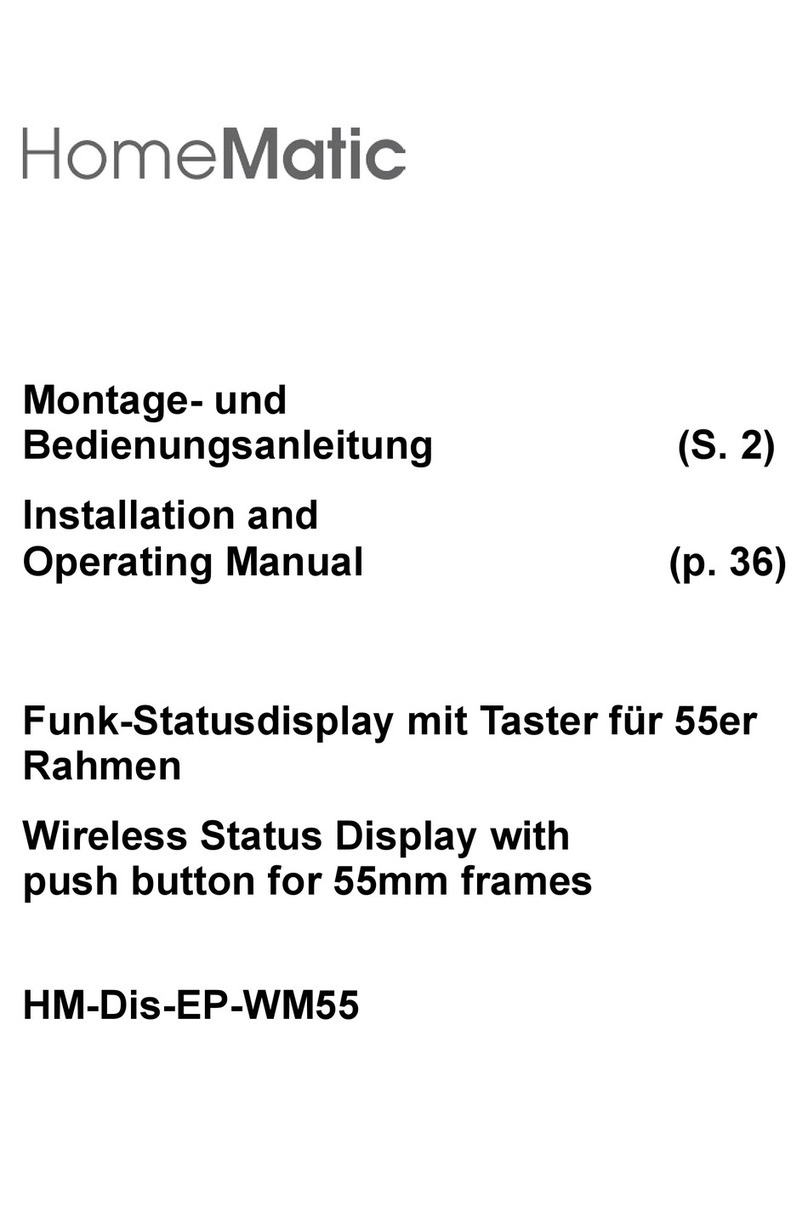
HomeMatic
HomeMatic HM-Dis-EP-WM55 Installation and operating manual

Radionics
Radionics Security System user guide

Conrad
Conrad 75 16 36 operating instructions
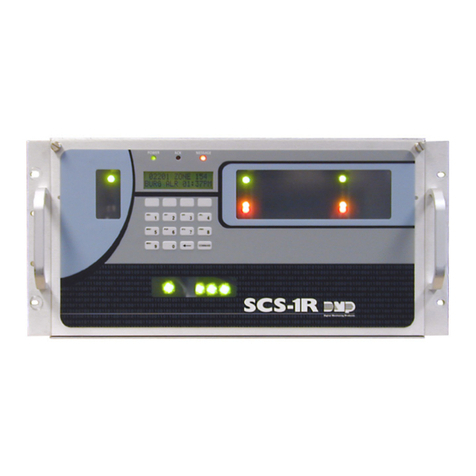
DMP Electronics
DMP Electronics SCS-1R installation guide

Amico
Amico Alert-3 LCD v2.3 Installation operating & maintenance manual
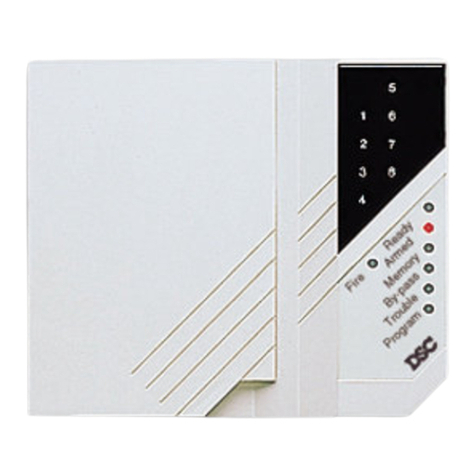
DSC
DSC PC2550 instruction manual
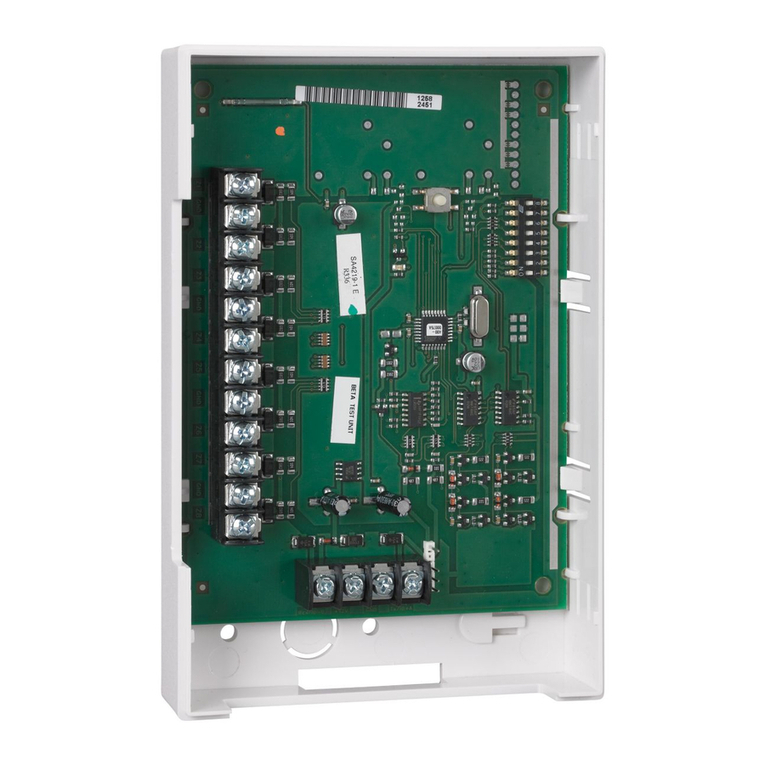
Honeywell
Honeywell 4219 installation instructions

Panasonic
Panasonic External Presentation unit 1728 Technical description

GE
GE 50246 - Smart Home Door Stop Alarm user manual
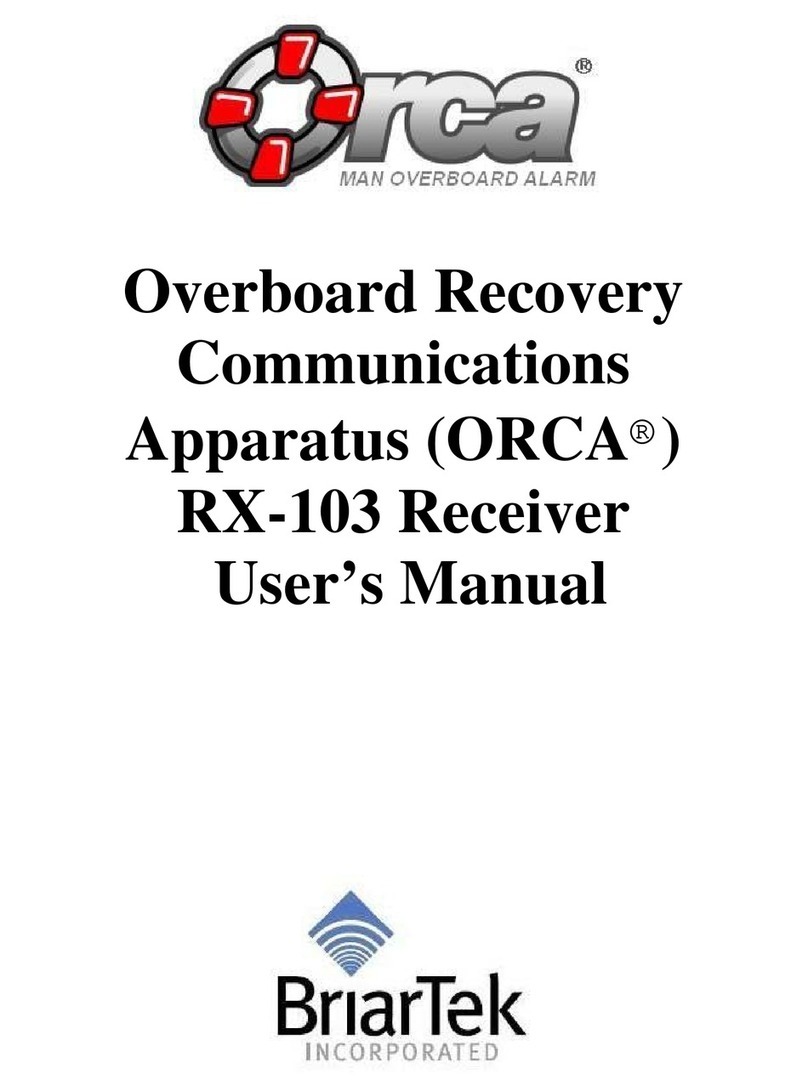
BriarTek
BriarTek ORCA RX-103 user manual

Vision Controls
Vision Controls Cam SS XP user manual

Feelsafe
Feelsafe OMNI 3000 Programming instructions

